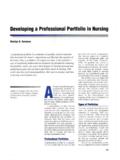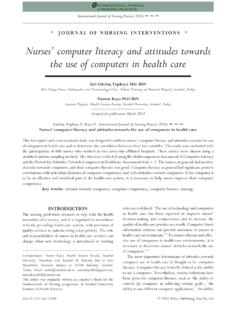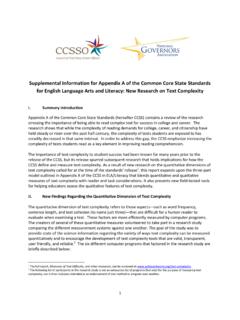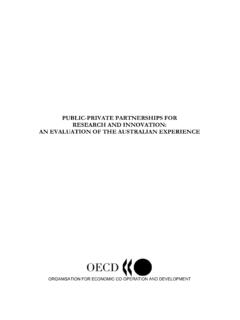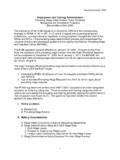Transcription of APPENDIX 1 WHAT IS THE ADVOCACY PROCESS?
1 APPENDIX 1 WHAT IS THE ADVOCACY PROCESS? The effectiveness and success of any ADVOCACY process depends, amongst other factors, on how well the following steps are implemented: Identifying and stating the issue Collecting the relevant information Mobilising interested people Raising and managing the necessary resources Networking Forming alliances Forming and sustaining coalitions Involving media Establishing contacts with government In summary, ADVOCACY begins with a problem or with a perception that there is a better alternative to a current condition and seeks to solve that problem and/or implement the selected alternative. ADVOCACY is both an art and a science. There are no strict rules for ADVOCACY work. Its approaches must be culturally, socially and politically specific. Widespread participation in an ADVOCACY campaign is generally a precondition for success. Planning an ADVOCACY campaign is a dynamic process.
2 It involves identifying the issue, developing solutions, building support, and bringing issues, solutions, and political will together to ensure that the desired change takes place. Finally, it involves monitoring and evaluating the entire process. The steps in planning for ADVOCACY work are: Know your issue Establish your objective(s) Conduct a stakeholder analysis Develop a strategy Plan the activities Identify and mobilise the required resources Monitor and evaluate the campaign s progress It may well be necessary to revisit and revise several of these steps throughout the implementation of your ADVOCACY campaign. Successful ADVOCACY does not proceed in a straight line and rarely unfolds exactly according to plan. Be prepared for unforeseen events and consequences. Be flexible. Civil society organisations derive their power from: their constituency their membership previous credible campaigns their experience their ability to analyse issues and events their commitment their contacts in government their ability to mobilise supporters WHO ARE THE STAKEHOLDERS IN ADVOCACY WORK AND WHAT ARE THEIR SOURCES OF POWER?
3 Some key stakeholders and their sources of power are: Government Election mandate, political authority, access to state resources, access to civil service, access to business, access to donors, access to other governments, membership of international organisations, influence over provincial and local government Civil society organisations Constituency / membership base, information drawn from development work, expertise, credibility, access to international networks / sector organisations Union federation Membership, money, access to union media, mobilisation skills Business Money, capacity to buy intellectual power, access to officials, access to media, power as employers Religious organisations Membership, moral authority, outreach Media Access to the public, variety of sources of information , communication skills, captive audiences WHY IS information A SOURCE OF POWER? information can be a source of power in ADVOCACY for several reasons: information drawn from ADVOCACY groups' own work can provide them with credibility and with the basis for alternative analysis to counter positions.
4 information or data, which is only available to government institutions can be used by government to influence arguments in favour of their own positions. information provided by ADVOCACY groups to communities regarding their constitutional rights empowers the people in those communities to assert their rights. information collected by ADVOCACY groups from other ADVOCACY groups in regional, national, or international organisations about experiences and policies elsewhere, and used in an ADVOCACY campaign, can help to influence local or national policy decisions. ADVOCACY TOOLSIn ADVOCACY , each issue demands different approaches and strategies, partners, tactics, methods, resources, materials, and so on. In embarking upon an ADVOCACY campaign, it is important to have the capacity to consider all available options and to make strategic choices amongst them. We call these options the "tools" of ADVOCACY .
5 Skilled and informed use of these tools results in greater ADVOCACY impact. The most important of these tools include: information : Gathering, managing and disseminating information lays the basis for determining the direction of an ADVOCACY campaign. Research is one way of gathering information . Research: Conducting research and policy analysis uses the information from various sources and develops it into policy options which become the key content of an ADVOCACY campaign. Media: Various media are used to communicate the campaign s message(s) to the different stakeholders. Social mobilisation: Mobilising the broadest possible support from a range of stakeholders, including the public at large, is essential to building the influence of the campaign. Lobbying: Convincing the decision-makers who have the power to make the desired change involves a set of special knowledge and skills. Litigation: Sometimes, using the court system to challenge a policy or law can reinforce an ADVOCACY campaign.
6 Networks, alliances and coalitions: Sharing of information and resources, and strength in unity and commonality of purpose are key to the success of ADVOCACY work. The choice of tools will vary, even in the context of a single campaign. It will depend on: The issue at hand; The strategic objectives; The message to be communicated; The stakeholders targeted; The relevant structures and processes involved; The time frame available; The resources available; The capacities of the ADVOCACY organisation(s) and their allies; The overall cultural, social, political and economic context. ADVOCACY is a complex task. Its objectives will not be achieved through the use of only one tool or method, but rather will require a carefully designed mixture of approaches. Groups should be flexible throughout their ADVOCACY campaign so that if one tool does not have the expected results, another can be tried.
7 The Media The media can be used in various ways to convey a message to different target audiences as part of an ADVOCACY campaign. While stressing the potential impact of the media, we need to first understand issues such as what do the media look for, what actually makes news, how ADVOCACY organisations can interact with different media, and importantly, the type of preparation that is required. It is essential, for the greatest impact in each case, to be strategic in the choice of media and the formulation of appropriate and clear messages. It is also important for ADVOCACY organisations to develop ongoing relationships with the relevant media organisations and individuals so as to build mutual respect and confidence. Social Movements Social movements are mass-based movements of the people which unite the people in a cause which cuts across their traditional barriers. They have played a crucial role in South African history.
8 Mass mobilisation remains an important ADVOCACY tool. The advantages noted above may strengthen an ADVOCACY campaign and speed its success. However, mass mobilisation may also create situations which the ADVOCACY leadership is unable to control and result in problems which damage the campaign. Therefore, as with all other ADVOCACY tools, careful consideration must be given to the benefits and risks before proceeding with mass mobilisation. Networks, alliances and coalitions Networks, alliances and coalitions can be potentially powerful tools in ADVOCACY work. However, ADVOCACY groups who are contemplating either forming or joining any one of them must give careful thought to the costs and benefits for their organisation as well as for the ADVOCACY campaign itself. Co-operation and co-ordination require planning, time and often money. Different forms of co-operation and co-ordination will suit different situations, and ADVOCACY groups should not feel locked into any one model.
9 However, the key principles underlying such relationships -- sharing information , experience and resources; building strength through unity; broadening support on important issues; and so on -- should always be a part of CSO ADVOCACY work. LOBBYINGWHAT IS LOBBYING?Lobbying is an organised attempt by an individual, an organisation or groups of individuals and/or organisations to influence on behalf of a particular interest all the stakeholders involved in preparing and passing legislation. Such stakeholders include ministerial advisers and staff, legislative drafters, policy makers, members of Parliament, portfolio committee members, select committees, the staff of various committees, experts and consultants serving those committees, etc. It also means seeking the support of an influential person or persons and providing accurate information which legislators can use in their decision-making. Lobbying is a give-and-take process that also involves gathering new information and analysis, which enables lobbyists to strengthen their own strategies.
10 WHAT IS THE DIFFERENCE BETWEEN LOBBYING AND ADVOCACY ?Lobbying is only one part of ADVOCACY - one tool amongst many. The difference between ADVOCACY and lobbying can be explained as follows: ADVOCACYLOBBYINGR elated to specific cause / issueGroup / collective effort Aimed at several stakeholders, both inside and outside of governmentRelated to specific legislationMay be individual or collective Aimed specifically at legislators and government officialsAimed at specific interestGolden rules of ADVOCACY and lobbying Get to know the key players Get to know the policy-makers Get to know the key committees and how they work Learn the art of good timing Create a political issue Observe the five commandments of lobbying: tell the truth promise more than you can deliver , so that you can understand what is going on , don't bypass staff and advisers not spring surprises when creating alliances Prepare properly Use the media strategically Develop your expertise Anticipate what the opposition will do Create strategic alliances (Adapted from Chapter 2 Network, 1995) Forms of ADVOCACY 1.


